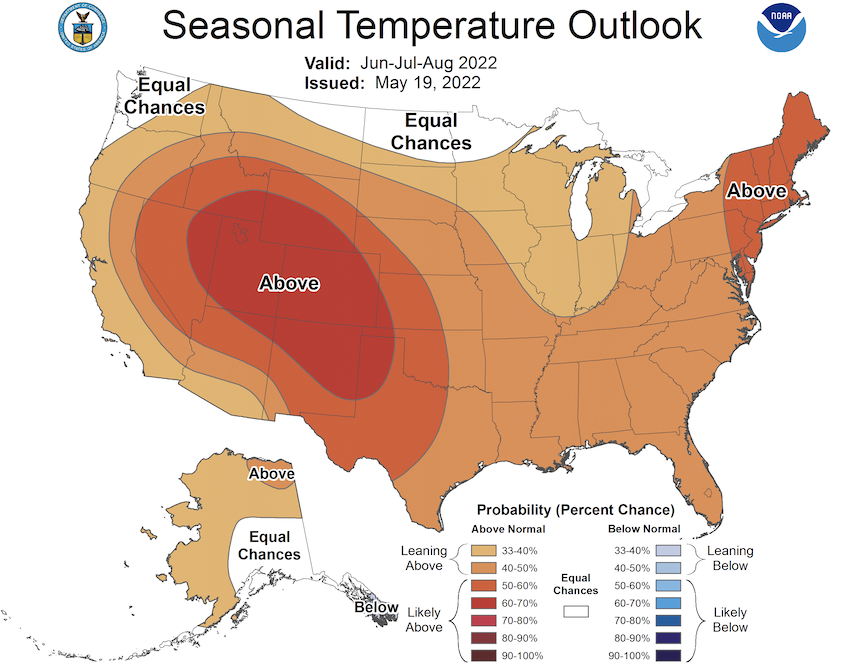by Bruce Bennett • Coming off last summer’s record-setting temperatures in western Washington, the summer of 2022 is not predicted to be quite as hot. Still, it could be hot enough to repeat some of the plant damage from last year and continue the problems with most types of needle- and broad-leaf evergreens through next summer. Now that our gardening neighborhood is forewarned, what actions can be taken to stop, or at least reduce, this summer’s heat-initiated damage to our favorite garden pollinators and people?
Overwatering — Heat is not the same as drought. When temperatures reach the 90s, some plants will begin to wilt or burn regardless of how well the soil is already irrigated. Avoid the temptation to overwater. Too much water can lead to fungal diseases. Also, refresh mulch if needed; a 2”–4” layer is ideal. A well-cared-for plant will perk back up as the cooler temperatures of evening come on.
Some plants, like peppers and tomatoes, may stop flowering and fruiting in really hot weather. They may simply drop their leaves, flowers and baby fruit because the plants can’t take up enough water fast enough to support itself until the weather cools down a bit. If you have had this problem more than a couple of times over the past few years, it is time to spend part of your winter seed catalog reading and choosing new varieties which are better adapted at handling hot weather. Remember that this may be a good time to make the most of this summer’s problem by planning for next summer’s garden.
Sunburn/Sun scorch — Yes, plants and fruit, even the dark-leaved ones, can get sunburned. Sun scorch can happen to newly installed plants or established ones that experience more sun exposure or heat than they can accommodate. With smaller plants, consider providing temporary shading with sun sails, shade cloth, or taller, sun-loving plants. For larger shrubs and trees, all you can do is keep up with irrigation. Your evergreens may not show any sun damage until next spring.
Blossom End Rot — Plants like cucumbers, peppers, squash and tomatoes, are more likely to develop black spots on their bottoms in hot weather. This is more the result of a calcium deficiency in the soil than it is by heat and is usually caused by inconsistent watering. The best response is to water less often but more deeply. This will break the wet/dry cycle that is the leading cause of blossom end rot. It would probably be a good idea to do a soil test on your veggie beds if you haven’t done one in a few years.
Protect yourself — there are physical needs which should be addressed while being in the garden, and actions you can take to protect yourself.
Avoid gardening during the hottest part of the day. Work outdoors during the first or last few hours of the day without the hot sun. Think about morning with a cup of coffee and afternoon with a glass of iced tea. Speaking of which…
Stay hydrated — Your body can’t perspire and cool you if you are short on fluids. Start by drinking a tall glass of water before you go out and “top-up” with a glass or so every hour.
Clothing is a good thing — Growing-up a natural redhead, my later years have seen my share of bits and pieces removed from my body because of carcinomas and melanomas. So, from the horse’s mouth, long-sleeve shirts, long pants and a broad-brimmed hat to protect ears and neck should be the go-to clothing-of-the-day. If you can’t stand clothes, use an SPF 30+ (and tall fences). You’ll thank me in 20 years (and your neighbors will thank you now).
Take breaks. Remember those glasses of iced tea I mentioned earlier? Continue to enjoy them every hour or so with at least a 10-minute break in the shade each hour. Allow your body to cool down a bit and allow your muscles to recover their energy and your joints to stop complaining of overuse. These breaks are more important as you sneak-up on and then surpass the age of 50.
Know the signs of heat stress and heat stroke — Heat stress symptoms are dizziness, headache, muscle cramps, nausea, profuse sweating; heat stroke symptoms are throbbing headache, dizziness, hot, dry skin, confusion and disorientation. If you are showing such symptoms, it’s time to call 911, your neighbor and move to a cool, shady location.
The key to working in a summer garden is managing heat issues to minimize heat stress on both your plants and yourself. Keep both well-watered according to their respective norms, and use mulch or SPF 30+ to protect the tender parts of both. And, every now and again, relax in the shade. In the words of Hill Street Blues’ Sgt. Phil Esterhaus, “Let’s be careful out there.” Happy gardening all!
Contributing columnist Bruce Bennett is a WSU Master Gardener, lecturer and garden designer. If you have questions concerning this post, have a question to ask or want to suggest a topic for a future post, contact him at gardenguy4u@gmail.com.


